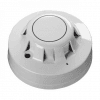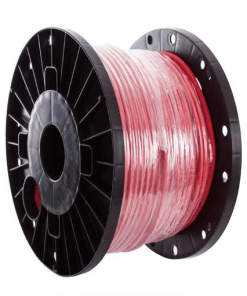Asenware Fire Alarm Resistant Cable
KSh 13,000.00 Original price was: KSh 13,000.00.KSh 12,000.00Current price is: KSh 12,000.00. excl. VAT
Fire proof cable is the flame retardant cable lines which can remain open in the fire, to still be able to normal power supply and information transmission.
Buy online at Best price in Nairobi Kenya
Visit our store and enjoy:
- Genuine, brand new, sealed stock
- Price-match against authorized dealers
- Installation & configuration services available
- Expert advice on compatibility with your network
SKU: HB33069
Categories: Asenware Alarm, Fire Alarms
Asenware Fire Alarm Resistant Cable overview
AW-FPC2×2.5 Fire Proof Cable is used where critical circuits need to function to keep safety equipment running even when exposed to extreme heat or fire.


product video:
Security & Fire Alarm proof Cable Products test
Specification:
| Model | AW-FPLR2X2.5 (14 AWG) |
| Conductor | 1/1.63 solid bare copper |
| Max conductor resistantΩ/KM(20℃) | 8.45 |
| Insulation thickness | 0.51 mm |
| Min insulation thickness | 0.46 mm |
| Inner wire | brown,blue(flame retardant PVC) |
| Wire numbers | 2 core |
| Drain wire | 0.4mm tinned copper |
| Wrapping | Al-foil |
| Jacket | red(flame retardant PVC) |
Key Features of Asenware Fire Resistant Cables
- Fire Resistance:
- High-Temperature Tolerance: Asenware Fire Cable are designed to withstand high temperatures and continue functioning during a fire.
- Fire Retardant Materials: Made with fire-retardant materials to prevent the spread of fire along the cable.
- Circuit Integrity:
- Maintains Electrical Integrity: Ensures continuous power supply and communication during a fire, allowing fire alarm systems to function correctly.
- Durability Under Stress: Built to endure extreme conditions without degrading or losing performance.
- Shielding and Insulation:
- High-Quality Insulation: Uses advanced insulation materials to prevent short circuits and electrical failures.
- EMI/RFI Shielding: Equipped with shielding to protect against electromagnetic and radio frequency interference, ensuring clear signal transmission.
- Compliance and Standards:
- International Standards: Complies with international standards such as BS 7629-1, BS 6387, and IEC 60332-3, ensuring high safety and performance levels.
- Certifications: Certified by relevant authorities, guaranteeing reliability and adherence to safety norms.
- Versatility:
- Various Applications: Suitable for use in fire alarm systems, emergency lighting circuits, and other critical safety systems.
- Different Types and Sizes: Available in various types and sizes to meet specific installation requirements and system needs.
Benefits of Using Asenware Fire Alarm Resistant Cables
- Enhanced Safety:
- Reliable Performance in Emergencies: Ensures that fire alarm systems remain operational during a fire, providing timely alerts and enabling safe evacuation.
- Prevents Fire Spread: Fire retardant properties help to contain and prevent the spread of fire, enhancing overall building safety.
- Compliance with Regulations:
- Meets Safety Standards: Adheres to stringent safety standards and regulations, ensuring compliance with local and international fire safety codes.
- Peace of Mind: Provides assurance that the fire alarm system infrastructure meets required safety benchmarks.
- Durability and Longevity:
- Robust Construction: Built to last, these cables offer long-term reliability, reducing the need for frequent replacements or maintenance.
- Resistance to Environmental Factors: Capable of withstanding harsh environmental conditions, including humidity, chemicals, and physical stress.
- Clear and Reliable Communication:
- Minimizes Interference: Shielding protects against interference, ensuring clear and reliable communication between fire alarm system components.
- Consistent Power Supply: Maintains a consistent power supply to all parts of the fire alarm system, ensuring it functions correctly when needed.
- Cost-Effective:
- Reduced Maintenance Costs: Durable and reliable cables reduce the need for frequent maintenance and replacements, leading to cost savings over time.
- Protection of Assets: Ensures the integrity of fire alarm systems, protecting both people and property from fire-related damages.
Applications of Asenware Fire Alarm Resistant Cables
- Commercial Buildings:
- Office Complexes: Ensures the safety and evacuation of employees and assets during a fire.
- Shopping Malls: Provides reliable fire alarm communication to protect large crowds and valuable merchandise.
- Residential Buildings:
- Apartments and Condominiums: Ensures the safety of residents by maintaining fire alarm system integrity during a fire.
- High-Rise Buildings: Critical for ensuring that fire alarms operate across multiple floors without failure.
- Industrial Facilities:
- Factories and Warehouses: Protects workers and valuable inventory by ensuring continuous operation of fire alarm systems.
- Chemical Plants: Essential for environments with high fire risk, ensuring safety and regulatory compliance.
- Public Infrastructure:
- Hospitals and Healthcare Facilities: Ensures the safety of patients and staff by maintaining critical fire alarm functions.
- Schools and Universities: Protects students and staff, ensuring a safe environment during fire emergencies.
- Transportation Hubs:
- Airports and Train Stations: Ensures the safe evacuation of large numbers of passengers and staff.
- Subways and Underground Facilities: Maintains fire alarm operations in challenging environments.
Be the first to review “Asenware Fire Alarm Resistant Cable” Cancel reply
You must be logged in to post a review.
Related products
-12%
Fire Alarms
Rated 5 out of 5
-14%
Fire Alarms
Rated 5 out of 5
-4%
Fire Alarms
Rated 5 out of 5
-6%
Fire Alarms
Rated 5 out of 5
-12%
Fire Alarms
Rated 5 out of 5
-14%
Dahua Store Kenya














Reviews
There are no reviews yet.